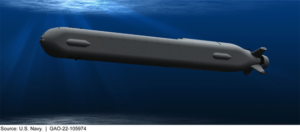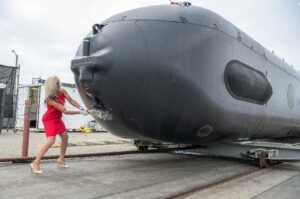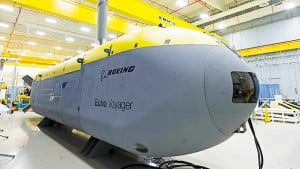A Government Accountability Office (GAO) report released Wednesday found the Navy’s Orca Extra Large Unmanned Undersea Vehicle (XLUUV) program is at least three years late and 64 percent more expensive than originally planned.
The GAO report argued that while the Navy determined the XLUUV was critical for an emergent need, which generally requires the capability to be provided within two years, the service did not develop a sound business case, leading to cost and time overruns.

The Navy’s FY ‘23 budget request documents show the XLUUV program has grown in price from its original estimate by at least $242 million, or 64 percent, with the Navy now planning to spend $621 million to build the five vehicles compared to the original $379 million.
The XLUUV program came out of a Joint Emergent Operational Need (JEON) the Navy identified in early 2015. Department of Defense guidance states capability gaps in the JEON process should be addressed within two years. In 2017 the Navy identified the XLUUV program as a solution for this JEON and planned to buy up to five vehicles as a research and development effort.
GAO noted while the Navy considers these five XLUUVs to be prototypes, it also plans to use them for military operations as soon as possible to fulfill the JEON. However, GAO said the Navy never developed an executable plan or business case to ensure the first XLUUV would be delivered within two years.
In 2017, Boeing [BA] and Lockheed Martin [LMT] won $42 million and $43 million contracts for Phase I of the program (Defense Daily, Sept. 29, 2017).
The Navy then downselected to Boeing in 2019, when Naval Sea Systems Command (NAVSEA) awarded Boeing [BA] a $42 million contract modification to build four 54-inch XLUUVs to support mine countermeasures; anti-submarine warfare; and intelligence, surveillance and reconnaissance (ISR) missions. The Navy said the pier-launched vehicle is supposed to be an accelerated acquisition program, which was later increased to five vehicles (Defense Daily, Feb. 14, 2019).
Boeing’s design is based on its largest civilian UUV, the Echo Voyager. In 2017 Boeing said it was working with HII [HII] on the XLUUV competition (Defense Daily, June 8, 2017).
GAO noted the initial construction contract called for the first vehicle to be delivered within two years, by December 2020, with a ceiling price to build all five vehicles for $281.5 million.
By 2021 the Senate Appropriations Committee was concerned with the Navy’s progress in the FY ‘22 defense appropriations bill report. The committee was skeptical of the Navy’s request for another $58 million in the FY ‘22 budget to continue building the XLUUVs for additional requirements, “when the baseline program is performing poorly.” That was in addition to at least two fiscal quarters of schedule delays and an 19-month delay related to the FY ‘21 budget request that means the program has to be restructured (Defense Daily, Oct. 19, 2021).

Therefore, the final appropriations act directed the GAO to review the Navy’s adherence to best practices for rapid acquisition programs with the XLUUV.
The GAO found the delays and cost overruns in the program can be partially attributed “ to the Navy’s decision to not require the contractor to demonstrate its readiness to fabricate the prototype XLUUVs, as called for by leading acquisition practices. Without knowledge to inform decision-making, delays ensued as the contractor implemented updates, revisions, and alterations after the Navy contracted to purchase the five XLUUVs in February and March 2019, according to Navy officials.”
The report found the $242 million-plus cost growth is due to several factors. $73 million in growth is from a test vehicle added to the contract last March, set to be delivered in October. The Navy plans to use the test vehicles for testing and fleet familiarization while the contractor builds the five prototype vehicles. The Navy explained other parts of the cost growth were adding another $43 million for the design phase, $50 million for the fabrication phase, $21 million for an XLUUV test site and $55 million in increased program office costs “resulting from the effort taking longer than planned.”
Notably, none of these additions, including the test vehicle and test site, were in the original cost estimate.
Without requiring the contractor to demonstrate its readiness to build and deliver XLUUVs with all modifications from the base commercial design, called a Production Readiness Review (PRR), schedule delays accumulated “as the contractor struggled to fabricate the XLUUV, which has key differences from the Echo Voyager prototype it previously built, according to Navy officials.”
GAO noted PRRs are recommended in leading acquisition practices and the process could have informed the Navy about Boeing’s ability to build the XLUUVs.
“We believe that leading practices we identified are applicable to the XLUUV and illustrate that adopting certain elements of a production readiness review would have helped inform the Navy’s cost and schedule targets and its decision-making,” the report said.
Navy officials told GAO they reviewed the contractor’s readiness for fabrication as part of the critical design review, but “these officials neither elaborated on what they assessed nor were they able to provide us with any documentation of this review.”
GAO underscored the Navy’s requirements for the XLUUV involved several major changes to the design for critical components. Notably, the battery differences were so significant that Boeing chose a new subcontractor for the battery, which involved creating a new battery design. As of June 2022 “the subcontractor has yet to deliver the newly designed battery to the Navy for testing. Without the battery, the Navy may have to alter the fabrication schedule for the vehicle.”
GAO argued that developing a reasonable schedule allows decision-makers to make “informed trade-off decisions because it highlights the risks and activities most likely to delay an effort. In the case of XLUUV, by not analyzing the XLUUV schedule, the Navy missed the opportunity to focus attention on the uncertainty of fabricating an XLUUV that would meet the Navy’s requirements.”
“The Navy also missed the opportunity to assess the uncertainty inherent in the effort and use this assessment to create a more accurate schedule. Further, this analysis could have triggered the Navy to make trade-off decisions if the planned schedule was not congruent with the goals of the effort,” the report continued.
GAO also noted the Navy has still not decided what parts of acquisition guidance XLUUV will follow in the future, since it plans to eventually transition XLUUV to an acquisition program.

“As a result, the Navy has yet to modify the XLUUV’s acquisition strategy to include future capability, including whether or not the Navy will require a production readiness review for any future construction of additional XLUUVs.”
The Navy is requesting $117 million in FY ‘23 in part to start assessing the possibility of future XLUUV capabilities beyond the needs from JEON. GAO warned this indicates the Navy could ultimately bypass PRR requirements before starting production and deployment, which would mean the Navy “would miss the opportunity to gain knowledge about the effort’s risks, such as whether the contractor can meet cost, schedule, and performance targets.”
Now the first XLUUV is expected to be over three years late. The vehicles were originally planned to be delivered between December 2020 and 2022.
GAO said as of June the Navy is still rebaselining the vehicle delivery schedule and still does not have new estimated delivery dates, but the contractor “has tentatively targeted February 2024 to June 2024 for delivery of all five vehicles.”
The report recommends the Navy Secretary ensure the XLUUV acquisition office includes a production readiness review as part of its acquisition strategy for any subsequent LXUUV purchases and that the office develop more complete cost and schedule estimates that follow leading practices. The Navy concurred with these recommendations.